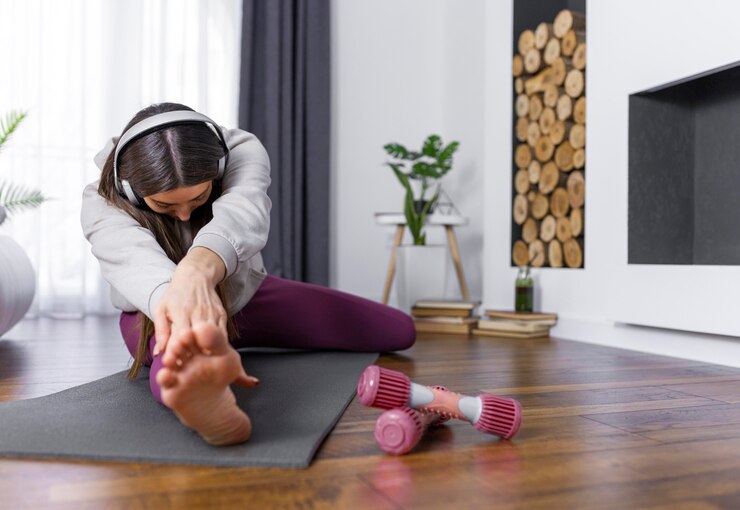Introduction to Flexibility Exercises
Flexibility Exercises for Beginners is an essential component of overall fitness and well-being. While many people focus on strength and cardiovascular exercises, flexibility exercises often take a back seat. However, improving flexibility can enhance performance in physical activities, prevent injuries, and promote better posture.
Understanding the Importance of Flexibility
Flexibility refers to the ability of your joints and muscles to move through their full range of motion. It plays a crucial role in everyday activities such as bending, reaching, and twisting. As we age, our flexibility naturally decreases, making it important to incorporate flexibility exercises into our routine.
Common Misconceptions About Flexibility
One common misconception about flexibility is that it’s only necessary for athletes or yogis. In reality, everyone can benefit from improved flexibility regardless of their fitness level or age. Another misconception is that flexibility is only achieved through intense stretching. However, gentle and consistent stretching can also yield significant benefits.
Benefits of Flexibility Exercises
Flexibility exercises offer a wide range of benefits, including increased joint mobility, reduced muscle tension, improved circulation, and enhanced posture. They can also help alleviate stiffness and soreness, especially after prolonged periods of sitting or physical activity.
Different Types of Flexibility Exercises
There are several types of flexibility exercises, including static stretching, dynamic stretching, and yoga. Static stretching involves holding a stretch position for a certain period, while dynamic stretching involves moving through a range of motion. Yoga combines stretching, strength, and breathing exercises to improve flexibility and mindfulness.
How to Start Flexibility Training
Before starting flexibility training, it’s essential to set realistic goals and understand your body’s current limitations. Begin with a proper warm-up to prepare your muscles and joints for stretching. Gradually increase the intensity and duration of your stretches to avoid injury.
Flexibility Exercises for Beginners
Neck Rolls
Gently roll your neck from side to side, making full circles to release tension in the neck and shoulders.
Shoulder Stretches
Bring one arm across your body and gently press it with the opposite hand, holding for 15-30 seconds on each side.
Arm Circles
Extend your arms to the sides and make small circles in a clockwise and counterclockwise motion to improve shoulder flexibility.
Leg Stretches
Sit on the floor with legs extended, and reach towards your toes, holding the stretch for 15-30 seconds to stretch the hamstrings.
Hamstring Stretches
Lie on your back and bring one leg towards your chest while keeping the other leg extended on the floor, holding for 15-30 seconds on each side.
Tips for Safe Flexibility Training
To ensure safe and effective flexibility training, avoid overstretching and listen to your body’s signals. Focus on proper breathing techniques to enhance relaxation and flexibility.
Incorporating Flexibility into Your Routine
Include flexibility exercises as part of your regular workout routine, aiming for at least 10-15 minutes of stretching after each workout session.
Tracking Progress and Adjustments
Keep track of your flexibility progress by measuring improvements in range of motion and ease of movement. Adjust your stretching routine as needed to target specific areas of tightness or discomfort.
Staying Consistent with Flexibility Training
Consistency is key to maintaining and improving flexibility over time. Find enjoyable ways to incorporate flexibility exercises into your daily life, such as stretching breaks during work or before bedtime.
Addressing Common Challenges
Some common challenges in flexibility training include impatience with results and discomfort during stretching. Remember that progress takes time, and it’s normal to experience some discomfort during stretches. Be patient and persistent in your practice.
Flexibility Exercises and Mental Well-being
In addition to physical benefits, flexibility exercises can also promote mental well-being by reducing stress, improving relaxation, and enhancing mindfulness.
Conclusion
Flexibility exercises are an integral part of a well-rounded fitness routine, offering numerous benefits for physical and mental health. By incorporating gentle stretches and mindful movement into your daily life, you can improve flexibility, prevent injuries, and enhance overall well-being.
FAQs on Flexibility Exercises
- How often should I do flexibility exercises?Aim to stretch major muscle groups at least two to three times per week, or more frequently if possible.
- Can flexibility exercises help with back pain?Yes, regular stretching and flexibility exercises can help alleviate tension and improve posture, which may reduce back pain over time.
- Is it better to stretch before or after exercise?It’s generally recommended to perform dynamic stretches before exercise to warm up the muscles and static stretches after exercise to improve flexibility.
- Can I overstretch during flexibility exercises?Yes, overstretching can lead to injury. It’s essential to stretch gently and within your body’s limits, avoiding any sharp pain or discomfort.
- Are there specific flexibility exercises for seniors?Yes, there are many gentle stretching exercises tailored to seniors to improve flexibility and mobility while taking into account any existing health conditions.



